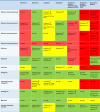Pharmacologic Considerations in the Treatment of Hepatitis C Virus in Persons With HIV
- PMID: 27363437
- PMCID: PMC4928451
- DOI: 10.1093/cid/ciw220
Pharmacologic Considerations in the Treatment of Hepatitis C Virus in Persons With HIV
Erratum in
-
Mac-Brayne CE et al (Clin Infect Dis 2016; 63[suppl 1]:S12-23).Clin Infect Dis. 2016 Sep 1;63(5):715. doi: 10.1093/cid/ciw459. Epub 2016 Jul 19. Clin Infect Dis. 2016. PMID: 27436423 Free PMC article. No abstract available.
Abstract
Roughly one-third of individuals living with the human immunodeficiency virus (HIV) are coinfected with the hepatitis C virus (HCV) due to shared routes of transmission. HIV accelerates the progression of HCV disease; thus, coinfected individuals are at high priority for HCV treatment. Several new HCV therapies, called direct-acting antiviral agents (DAAs), are available that achieve cure rates of >90% in many patient populations including individuals with HIV. The primary consideration in treating HCV in HIV-infected persons is the potential for drug interactions. We describe the clinical pharmacology and drug interaction potential of the DAAs, review the interaction data with DAAs and antiretroviral agents, and identify the knowledge gaps in the pharmacologic aspects of treating HCV in individuals with HIV coinfection. This review will focus on DAAs that have received regulatory approval in the United States and Europe and agents in late stages of clinical development.
Keywords: coinfection; direct-acting antivirals; drug interactions; hepatitis C virus; human immunodeficiency virus.
© The Author 2016. Published by Oxford University Press for the Infectious Diseases Society of America. All rights reserved. For permissions, e-mail journals.permissions@oup.com.
Figures


References
-
- Rockstroh JK, Mocroft A, Soriano V et al. . Influence of hepatitis C virus infection on HIV-1 disease progression and response to highly active antiretroviral therapy. J Infect Dis 2005; 192:992–1002. - PubMed
-
- Alter MJ. Hepatitis C virus infection in the United States. J Hepatol 1999; 31(suppl 1):88–91. - PubMed
-
- Martinez-Sierra C, Arizcorreta A, Diaz F et al. . Progression of chronic hepatitis C to liver fibrosis and cirrhosis in patients coinfected with hepatitis C virus and human immunodeficiency virus. Clin Infect Dis 2003; 36:491–8. - PubMed
-
- Benhamou Y, Bochet M, Di Martino V et al. . Liver fibrosis progression in human immunodeficiency virus and hepatitis C virus coinfected patients. The Multivirc Group. Hepatology 1999; 30:1054–8. - PubMed
Publication types
MeSH terms
Substances
Grants and funding
LinkOut - more resources
Full Text Sources
Other Literature Sources
Medical

